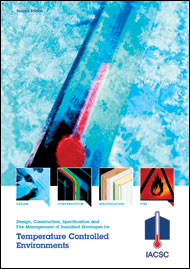 The Motor Cycle Museum, Birmingham was the venue for the formal seminar to launch of the second edition of Guidelines for the Design, Specification, Construction, Maintenance and Fire Management of Insulated Envelopes for Temperature Controlled Environments produced by the International Association for Cold Storage Construction. Paul Everall, CEO of Local Authority Building Control (LABC) opened proceedings by giving an overview of current proposed changes in Building Control and warmly welcomed the new Guide, especially as fire concerns still prevail in the design of large insulated ‘sheds.’ He particularly liked the tick list for BCBs to use as this highlights the critical Fire Safety issues.
The Motor Cycle Museum, Birmingham was the venue for the formal seminar to launch of the second edition of Guidelines for the Design, Specification, Construction, Maintenance and Fire Management of Insulated Envelopes for Temperature Controlled Environments produced by the International Association for Cold Storage Construction. Paul Everall, CEO of Local Authority Building Control (LABC) opened proceedings by giving an overview of current proposed changes in Building Control and warmly welcomed the new Guide, especially as fire concerns still prevail in the design of large insulated ‘sheds.’ He particularly liked the tick list for BCBs to use as this highlights the critical Fire Safety issues.
Mark Newton gave a personal view of the insurers’ approach to new build with a plea for being asked to be involved at as early a stage as possible to ensure effective property protection. He listed some recent fires in insulated envelope buildings around the world noting that the UK fires appear only to be occurring in older properties that had not had the benefit of even the earlier guidance published in 1999. He felt sure the new guide would improve the situation even further.
Peter Jackman followed this by pointing out that this is the first document giving guidance on the mitigation of risk to be published since the Regulatory Reform (Fire Safety) Order (FSO) came into force in 2006. This second edition spreads the fire safety topics throughout the guide rather than just in ‘pink pages’ as in the first edition. Fire safety is always of great importance but it can now take its place alongside structural integrity and the need for flexibility of use.
The chapter on fire issues includes a summary of the relevant tests and the concepts of fire safety engineering in the context of the storage and food industry requirements recognising the insurance industry needs as well. The Guide outlines the interacting fire-related complexities that will need to be addressed by the design team in order to design against the fire risk. It then goes on to target the factors that Building Control Bodies need to consider before giving approval solely in respect of meeting the fire safety requirements of Building Regulations. The labelling scheme pioneered in the first edition and the associated core identification scheme has been brought up to date and will be a useful tool for those carrying out the regular risk assessments now called for by the FSO.
At present the Guide is available in hard copy only, price £95 plus £10 p&p, from IACSC (European Division) 20 Park Street, Princes Risborough, Bucks HP27 9AH.
Tel: 01844 275500
Email: IACSC@intfire.com




Comments are closed.